50+ Ouija Board Movies
This is a comprehensive list and cinematic overview of all the ouija board movies ever made.

Ouija boards have been in movies ever since the early days of cinema. Films often portray ouija boards as conduits for evil spirits, but the actual history of ouija is much less terrifying.
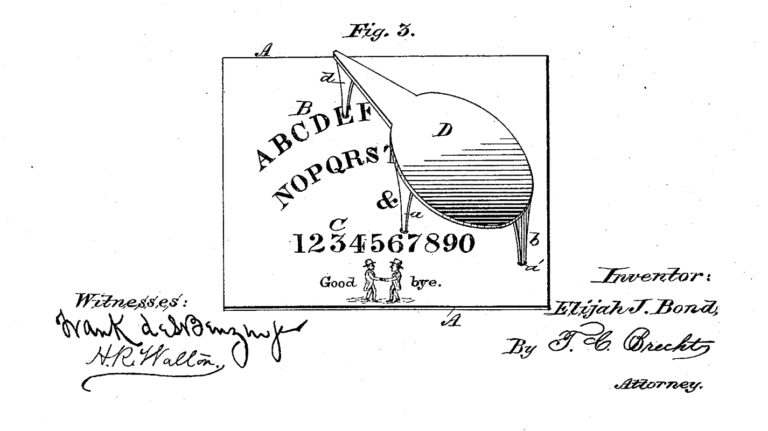
The term “ouija” was originally created for a patent granted in the United States in 1891 describing a “toy or game.” The Ouija board (with a capital “O” when referring to the trademarked name) quickly became a hit when the Kennard Novelty Company began selling them the same year. Ever since, the Ouija board has been the most popular form of divination for spiritualists and for those who are just curious.
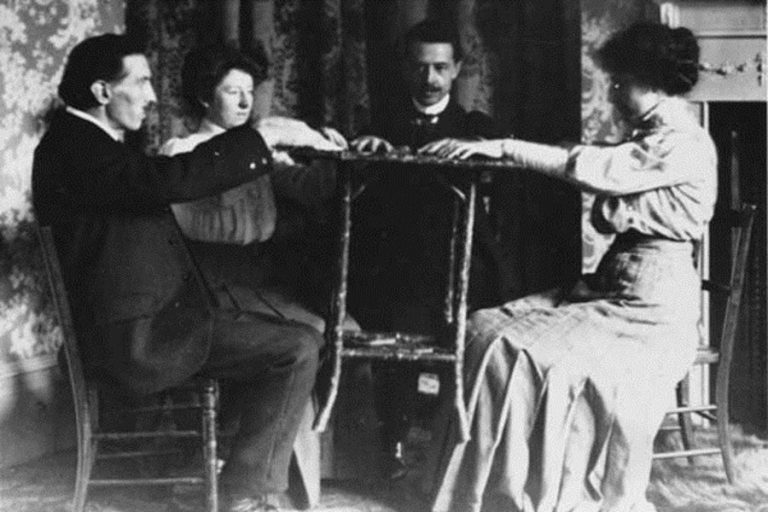
Early film appearances of ouija boards rarely involve spooks or scares. Films from the silent era through the early 1940s use ouija boards for comedic purposes or to advance plots which have earthly explanations for portrayals of the paranormal. Ouija and the supernatural was taken more seriously in cinema starting in the late 1940s. Then, in the 1970s, ouija boards took a dark turn by being portals to evil in almost every on-screen appearance.
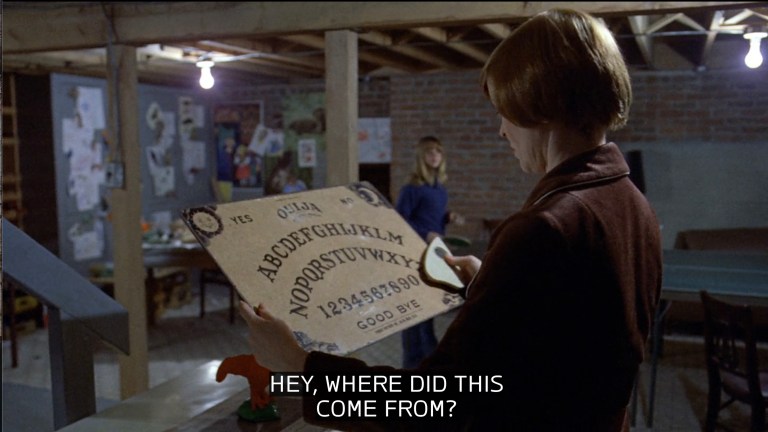
Ouija boards most often take a central role in subgenres of horror including haunted house and possession, but they can appear in just about any type of film. This list is an ongoing effort to catalog every appearance of ouija boards, whether used as a minor plot point or as the center of the action.
The Bat Whispers (1930)
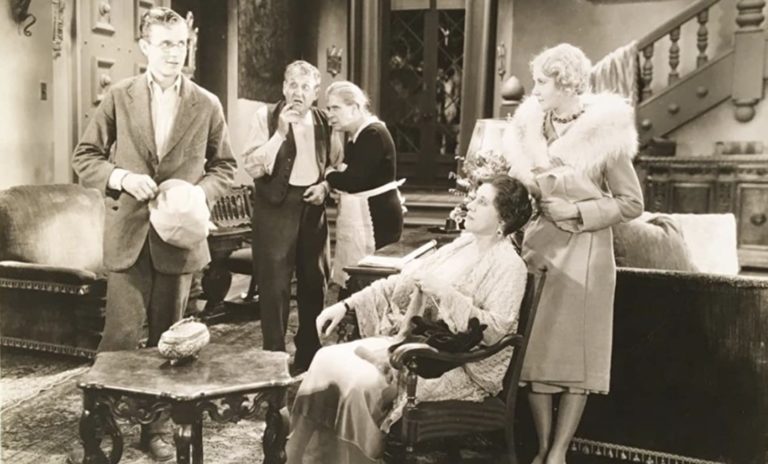
The story focuses on Cornelia Van Gorder (Grayce Hampton) and the isolated mansion she is renting in an attempt to get some peace and quiet out in the countryside. Mrs. Van Gorder’s plans for a quiet rest are shattered when strange occurrences within walls of the estate convince her maid, Lizzie (Maude Eburne), that the house is haunted. Mrs. Van Gorder isn’t so easily swayed, and in a scene very early in the film, she convinces Lizzie to use a Ouija board with her to determine the true source of the sights and sounds scaring the superstitious maid.
The use of the Ouija board in The Bat Whispers affects the story in a way that is opposite to many later films. Rather than revealing a spiritual origin for the goings-on in the house, the board points everyone’s attention to a mysterious criminal known only as “The Bat.” Indeed, anything in the movie which might have a spiritual origin instead has an earthly explanation as The Bat, along with a host of other people, stalks the grounds of the estate in search of money hidden somewhere on its grounds. Only the Ouija board itself seems to have a supernatural explanation.
The Uninvited (1944)

Though the film doesn’t technically employ the use of an official Ouija board, The Uninvited warrants inclusion in this list for its séance scene which establishes a frightening use of divination that would be seen again and again in later ouija movies. The Uninvited stars Ray Milland and and Ruth Hussey as Rick and Pamela Fitzgerald, a brother and sister who buy a beautiful seaside house in London. It doesn’t take long for the Fitzgeralds to realize that the house is haunted, and after discovering that Stella Meredith (Gail Russell), the granddaughter of the former owner, has a dangerous connection to the spirit, Rick and Pamela decide to hold a séance to convince Stella to stay away.

The device used to try to contact the spirit is effectively the same as a ouija board. Tiles with the letters of the alphabet are placed in a circle on a table along with cards reading “yes” and “no,” and an upside-down glass is used in place of a planchette. As the scene plays out, the answers become more ominous, indicating that Stella is in grave danger. The scene ends with the glass moving on its own before flying across the room and shattering against a wall. Stella is even briefly possessed after using the device, opening up the idea of divination might open a door through which spirits might pass. The sinister tone of the whole scene is more in line with what we’ve come to expect from the use ouija boards in horror movies.
13 Ghosts (1960)
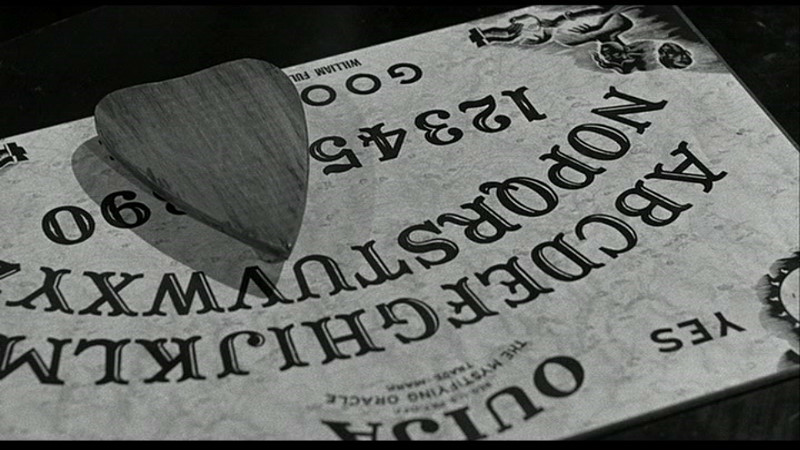
13 Ghosts takes the precedent set by The Uninvited and pushes it even further in this campy and fun haunted house movie from director and producer William Castle. Prior to 13 Ghosts, Castle had directed House on Haunted Hill (1959) and The Tingler (1959), both of which featured gimmicks in movie theaters (flying skeletons for House on Haunted Hill and buzzers in seats for The Tingler) meant to give audiences extra frights. For 13 Ghosts, Castle used a type of 3-D effect he called Illusion-O that allowed viewers to see the movie’s ghosts pop off the screen when wearing special glasses. The gimmick and the movie are really more fun than frightening, but the Ouija scene is a big exception to that rule.
Partway through the movie, the family that inherits the film’s haunted house decides to use a Ouija board for a little light-hearted fun. The scene starts off innocently enough, almost feeling like a commercial for the heavily marketed novelty, but things get dark very quickly. The board reveals that there are 13 ghosts in the house, and when the youngest member of the family, Buck (Charles Herbert), asks the ghosts if they have plans for murder, he is nearly crushed as a heavy picture and frame falls off the wall directly above him. The Ouija board’s planchette then floats off the board and lands in the lap of Bucks sister, ending what is one of the scariest Ouija board scenes to date.
The Exorcist (1973)
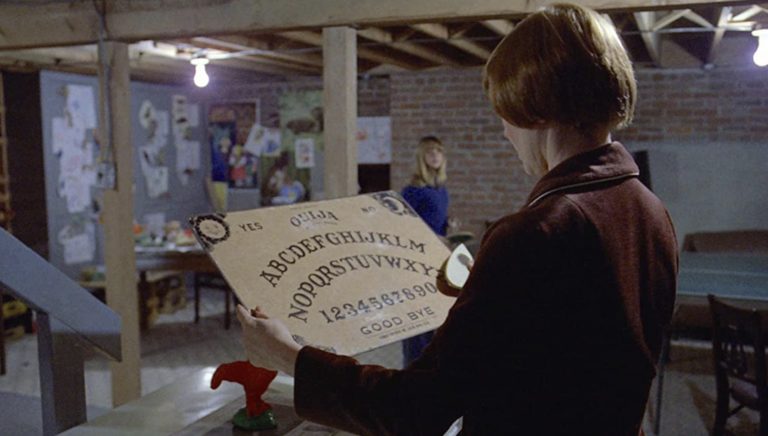
Director William Friedkin’s The Exorcist is widely regarded as one of the most absolutely terrifying movies of all time. The film stars Linda Blair as Regan, a 12-year-old girl who becomes possessed by a demon after coming into contact with a presence she refers to as Captain Howdy. Regan finds a Ouija board in a random closet, and when she attempts to introduce her mother Chris (Ellen Burstyn) to Captain Howdy by using the board, Captain Howdy wants nothing to do with it. The planchette zips away from Chris’s hands, and then it goes completely still. Though the scene might not be as instantly scary as other film encounters with Ouija, the implication that Regan has been conversing with an unknown presence by herself, a presence that ends up violently possessing her, is far more chilling.
Satan’s Blood (1978)
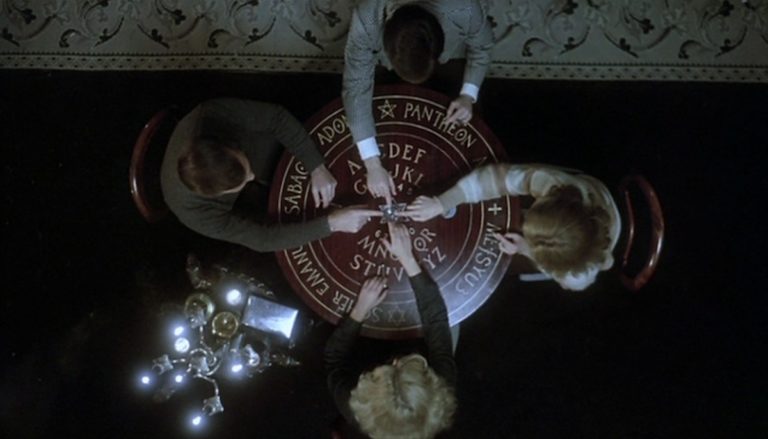
With disturbing violence, dark rituals, and more than a little graphic nudity, Satan’s Blood is a lurid Spanish film about unhinged Satanism during a time when the hysteria surrounding satanic cults was growing. In Satan’s Blood, a married couple, Andres (Jose Maria Guillen) and Ana (Mariana Karr), meet another couple, Bruno (Angel Aranda) and Berta (Sandra Alberti), while out on the town. One thing leads to another, and Andres and Ana end up joining Bruno and Berta for a ouija session at their home. The decorations in Bruno and Berta’s home indicate a strong interest in the occult, but the extent of their interest isn’t fully revealed until after the ouija session takes a turn for the sinister. Andres and Ana’s visit gets worse from there, and the couple ends up in a struggle to keep their lives and their souls intact. Heavy on atmosphere though sometimes light on story, Satan’s Blood will probably appeal most to fans of some of more trashy exploitation movies to come out of Europe in the 1970s.
Amityville 3-D (1983)

In the film, skeptical journalist John Baxter (Tony Roberts) moves into the supposedly haunted Amityville house after debunking a medium holding a fake séance in the home. John doesn’t believe in the paranormal, but he and his family begin to experience inexplicable events from the moment they move in. Late in the movie, John’s daughter Susan (Lori Loughlin) receives an ominous warning when using a ouija-like setting with her friends. The setup is similar to the one used years prior in The Uninvited with a circle of letters and an overturned glass used as a planchette. After the glass goes flying across the room, Susan, who was already spooked by the house, has no doubts about the danger she and her family are in.
The Devil’s Gift (1984)

The Devil’s Gift is a low-budget production about a possessed Jolly Chimp (a toy monkey that bangs cymbals together) that goes on a killing spree when it’s given to a young boy as a birthday present. The film opens on a scene in which a woman uses a Ouija board to contact someone named Thomas, but she ends up opening a gateway for a demonic force to inhabit the Jolly Chimp she has on a shelf. The monkey bangs its cymbals, and the woman is promptly exploded by a blast of lightning. The Devil’s Gift has its charm, but it is probably best viewed in its heavily-truncated form as part of an anthology film titled Merlin’s Shop of Mystical Wonders (1996) which was featured as a season-10 episode of the television comedy series Mystery Science Theater 3000.
Witchboard (1987)

Unlike many of the other movies so far in this list, Witchboard doesn’t just use a Ouija board as a one-time-use tool to move the plot forward. Instead, writer and director Kevin S. Tenney intended the Ouija board to be used as another character in the film. Witchboard stars Tawny Kitaen as Linda, a woman who is fascinated with talking to the spirit of a young boy named David. Linda’s ex-boyfriend Brandon (Stephen Nichols) becomes concerned that Linda is contacting David by herself, and Linda’s husband Jim (Todd Allen) has concerns about Linda’s time with both David and his former friend Brandon. The plot unfolds to reveal a number of fun, low-budget kills and some memorable scares, but the film ends up being as much a mystery as it is a supernatural horror movie. To Kevin S. Tenney’s credit though, the Ouija board does feel like it develops a personality of its own before the final credits roll.
Don’t Panic (1988)
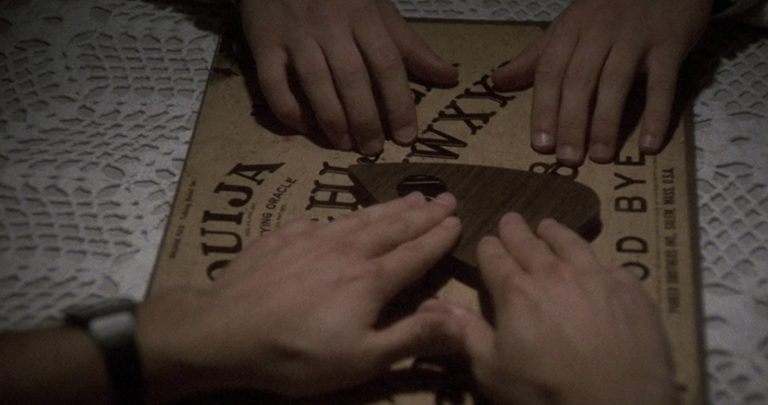
After Michael (Jon Michael Bischof) is given a Ouija board for his birthday, Michael becomes the prime suspect when his friends start dying in gruesome ways. Michael and his friends unleashed something evil when they tested out his new Ouija board, and Michael, who began having visions of the murders, is the only person who can stop the slaughter. Director Galindo’s film is quite an entertaining supernatural slasher that feels inspired by A Nightmare on Elm Street which came out just a few years prior.
Sorority House Massacre 2: Nighty Nightmare (1990)
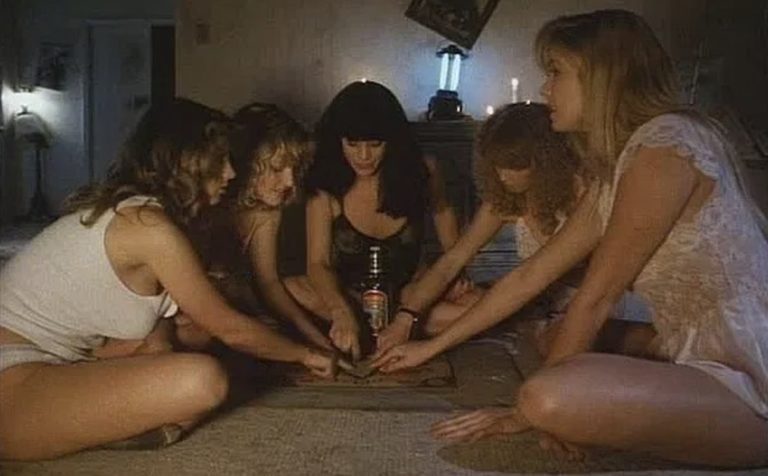
Sorority House Massacre 2: Nighty Nightmare is a prime example of the decline of the slasher movie by the year 1990. That’s not to say the movie isn’t enjoyable, there is plenty to love in Sorority House Massacre 2 for hardcore slasher fans, but with bad jokes, laughable acting, and questionable directing, the movie probably won’t win over anyone with just a passing interest in the slasher subgenre. However, the movie is particularly notable for being one of the few slashers to feature a Ouija board as a pivotal part of the plot.
In Sorority House Massacre 2, a group of five young women spend the night in the house they recently bought for their sorority. They discover that the house was so cheap because of a series of violent murders that took place there (which is shown in an extended flashback featuring footage pulled from the completely unrelated Slumber Party Massacre). Before the night is over, the young women also discover a Ouija board in the basement. They, of course, use the board to contact the murderer who died at the end of his killing spree, and then, of course, the women in the sorority begin dying in violent ways. Plenty of blood is splashed around the house and plenty of flesh is shown as the women never seem to be able to change out of their nighties (unless it’s to take them off) in this fun and trashy piece of stalk-and-slash horror.
Witchboard 2: The Devil’s Doorway (1993)

Though the story is unrelated to 1987’s Witchboard, the second film in the Witchboard series is similar to the first in its emphasis on mystery over supernatural scares. In Witchboard 2, Paige (Ami Dolenz) finds a Ouija board after moving in to a new apartment. The board connects Paige to an entity that calls itself Susan, and their conversations are nice and fun at first. As Paige learns more about Susan things take a sinister turn, but Paige’s connection to the entity might have already opened the door to possession.
Witchboard III: The Possession (1995)
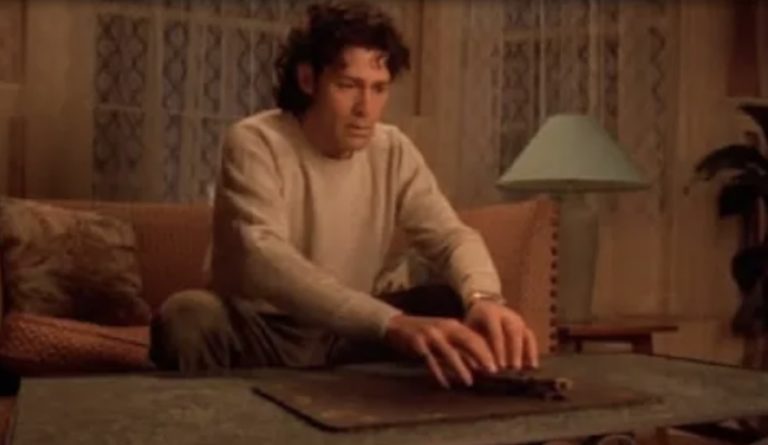
Like the previous film, the story of Witchboard III is unrelated to its prequels. In this, the final entry in the franchise, a demon disguised as a man uses a Ouija board to posses a man named Brian (David Nerman). Brian’s wife Julie (Elizabeth Lambert) begins to suspect something is wrong, and she embarks on a race against time to save her husband’s soul. The highlight of the film is probably the bonkers finale featuring a chase with a fully-formed demon, and there is a sufficiently creepy tone running throughout the movie.
What Lies Beneath (2000)
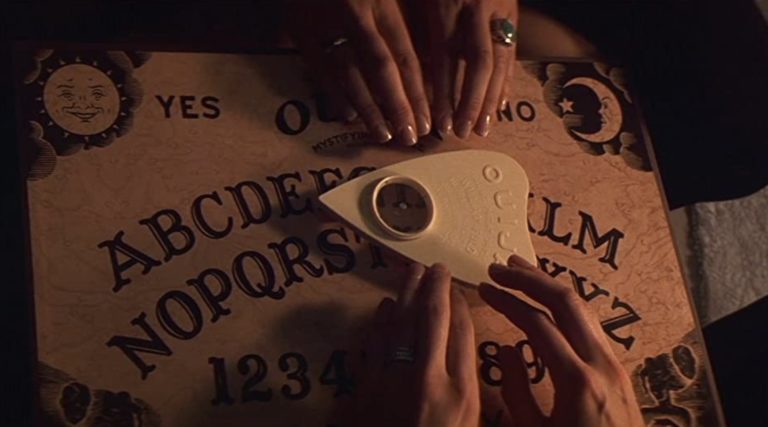
What Lies Beneath, directed by Academy Award winner Robert Zemeckis, is an interesting entry in this list. Being a well-crafted yet somewhat standard supernatural thriller doesn’t necessarily set it too far apart from anything else here, but its use of a Ouija board certainly makes it different. In the film, Claire (Michell Pfeiffer) senses a presence in the house she shares with her husband Norman (Harrison Ford). Claire has a friend who is a spiritualist, and the two of them use a Ouija board in an attempt to contact whatever is haunting Claire. Contrary to what audiences had been conditioned to expect from a Ouija board scene by the year 2000, the séance fails. No sinister force is introduced into Claire’s life through the board, and the planchette doesn’t fly across the room. Instead, the haunting manifests in different ways throughout the house, subverting viewers’ expectations and keeping them off-balance in a way that ends up being nice and creepy rather than outright scary.
Prison of the Dead (2002)
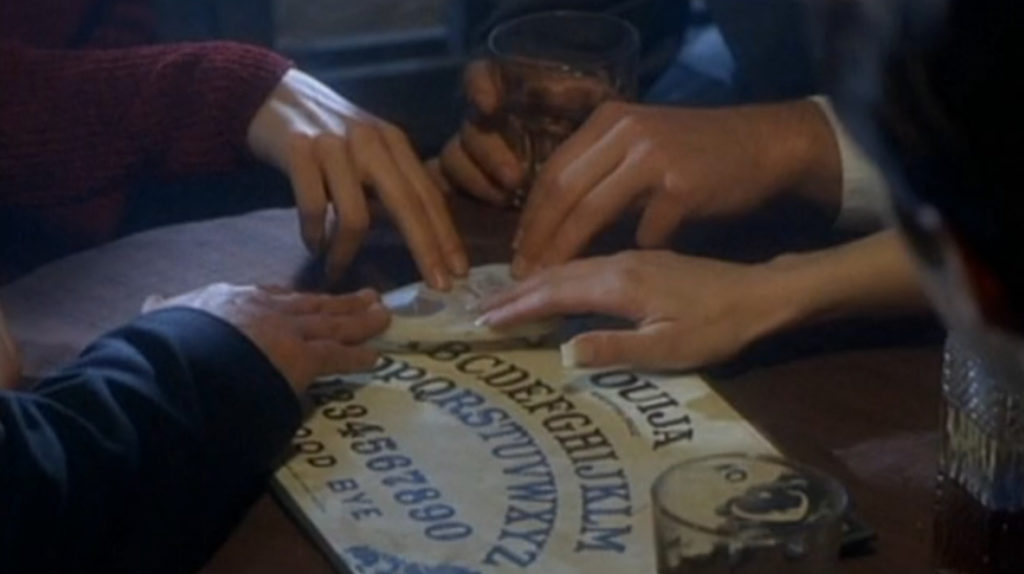
The story itself is weighed down by layers and layers of mythology which lead to an incredible amount of buildup before the action starts, but at least this low-budget horror flick looks nice. The story revolves around four people who come together for the funeral of their friend. As the twisted plot unravels, the friends learn more and more about the history of the funeral home and prison. Partway through the movie, the friends use a Ouija board which raises three of the prison’s executioners, Sickle, Mace, and Scythe, back from the dead. The executioners hunt the four friends, and the film ends by rewarding viewers with a series of violent and bloody scenes.
Long Time Dead (2002)
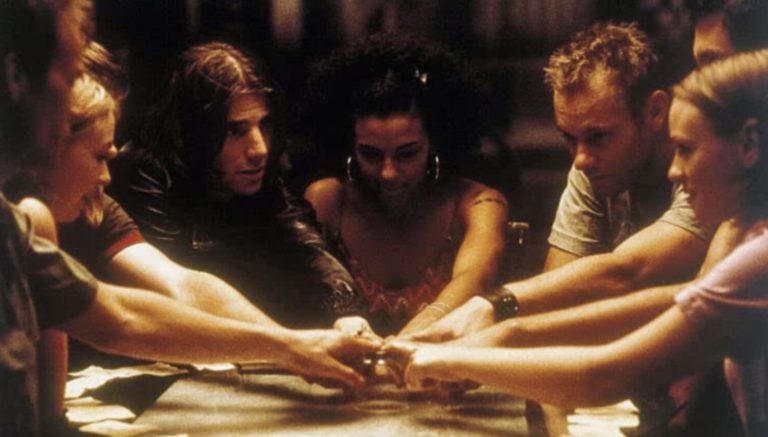
This well-made British horror movie follows a group of college students as they try to end a series of deaths after they unleash an evil djinn while messing around with a makeshift ouija board. The movie feels a lot like a the American teen slasher movies that were coming out around the same time, but that’s not a bad thing. It looks good, the characters are likeable, and the story progresses in a predictable but fun way.
Malefic (2003)

Presented in black and white with a visually interesting style, the movie focuses on a group of people who are hiding out in a cabin in the woods while they prepare to ransom the body of a child they stole. They find a Ouija board in the cabin, and, after messing around with with the board, they find themselves being hunted by a demonic force. Much of the movie feels amateurish, but in the best possible way. It really feels like the movie was made with passion, and that makes it a fun watch.
Paranormal Activity (2007)
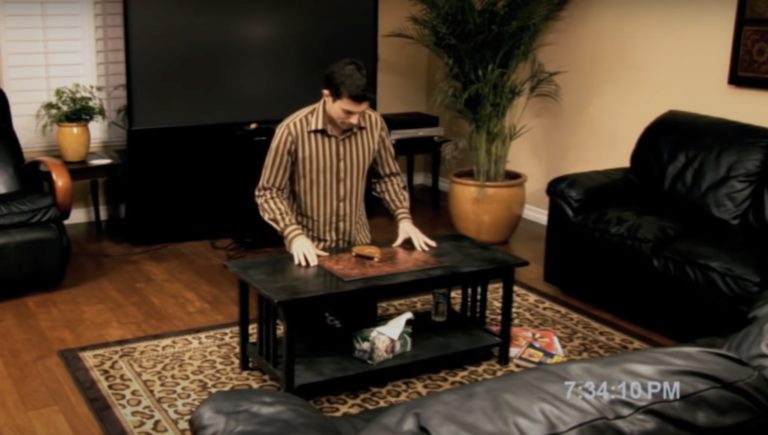
There are loads of great independent horror movies that come out every year, but Paranormal Activity is one of those rare independent movies that becomes a sensation through a combination of perfect timing, smart filmmaking, and brilliant marketing. The 2000s saw a rise in ghost hunting reality television shows with series like Most Haunted and Ghost Hunters piquing people’s interest in the supernatural. Paranormal Activity, with its found-footage aesthetic, often feels a lot like one of those ghost hunting shows, only with way more scares. The movie is a combination handheld footage and stationary cameras in a house inhabited by a woman who believes she is personally haunted and her husband who thinks it’s all a fun game.
The husband thinks another fun game might be to use a Ouija board, but, after an argument with his wife, the board is left in the living room untouched. Then, in one of the creepier moments in the movie, the board seemingly comes to life on its own while no one is around. Creepy moments like that turn into jarring scares throughout the movie, all building up to a terrifying finale. The film opened in theaters with little fanfare, but word of mouth and marketing that played up audiences’ reactions to the movie’s many frightening moments earned Paranormal Activity nearly $200 million.
I Am Zozo (2012)

Ostensibly based on a true story, I Am Zozo is an eerie low-budget psychological thriller based on paranormal research done by Darren Evans. Supposedly, a demonic force that calls itself Zozo has invaded hundreds of ouija sessions over the years, attacking the participants psychologically. Regardless of the authenticity of the real-life inspiration, I Am Zozo tells the story of five people who inadvertently summon Zozo on Halloween night. The movie is restrained in its approach to the supernatural, letting most of its creepiness play out through the characters’ emotions and reactions rather than traditional jump scares and spirit manifestations.
The Pact (2012)

The Pact is a tense and smart psychological thriller set inside a haunted house. The film stars Caity Lotz as Annie, a woman who returns to her family home after her mother passes away. Annie doesn’t want to go since the memories of abuse she suffered at the hands of her mother during childhood are still raw, but when Annie’s sister goes missing, she has no choice but to return home to search for answers. Annie’s search leads her into mystery involving ghostly happenings, a serial killer, and dark secrets that reside in her old home. When Annie’s investigation seemingly hits a dead end, she turns to a makeshift ouija board to try to uncover some answers. The revelations provided by her home’s resident spirit kick off the movie’s surprising and frightening finale.
Ouija (2014)
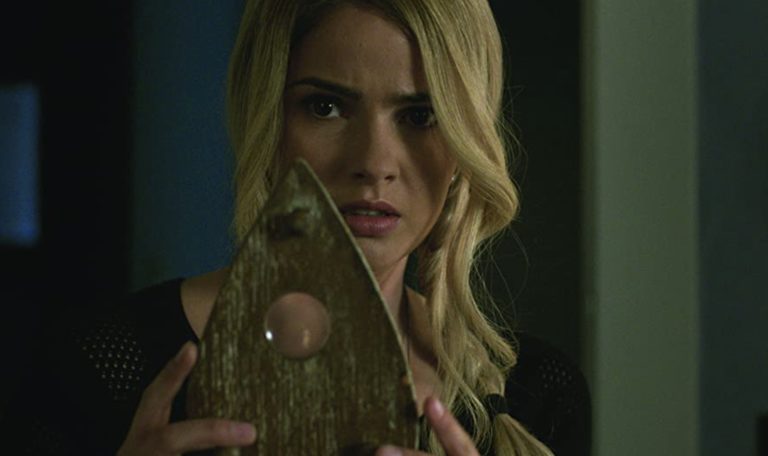
Produced in part by Hasbro, the toy company that acquired the rights to the Ouija name in 1991, Oujia is a movie that often feels like it’s the product of smashing together a teen horror movie with a really long commercial for Ouija boards. The movie starts by setting up the relationship between Laine (Olivia Cooke) and Debbie (Shelley Hennig), two childhood friends with an interest in Ouija. After Debbie, now a teenager, commits suicide, Laine and her friends attempt to contact Debbie with a Ouija session, but it seems like someone or something else made contact instead. There are some fun frights to be had in Ouija, and the appearance by horror icon Lin Shaye is a great bonus, but overall it’s a fairly tame PG-13 horror movie with a strong focus on mystery over tension.
Exorcist: The Fallen (2014)
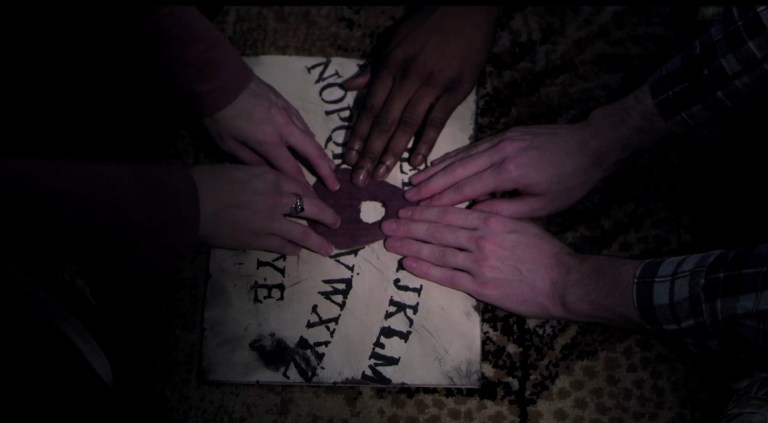
As Exorcist: The Fallen begins, we see a young woman named Victoria (Tara Marie Kirk) in bad, bloody condition as she is being exorcised. We then jump back in time to learn Victoria’s story. She and two of her friends tap into something evil while playing with a ouija board, and the bulk of the movie focuses on Victoria’s downward spiral into full-fledged demonic possession. Exorcist: The Fallen follows some well-worn track as it presents scenes similar to any number of possession movies, but there are some fun, gory highlights including a nightmare in which Victoria is spontaneously disemboweled.
The Conjuring 2 (2016)
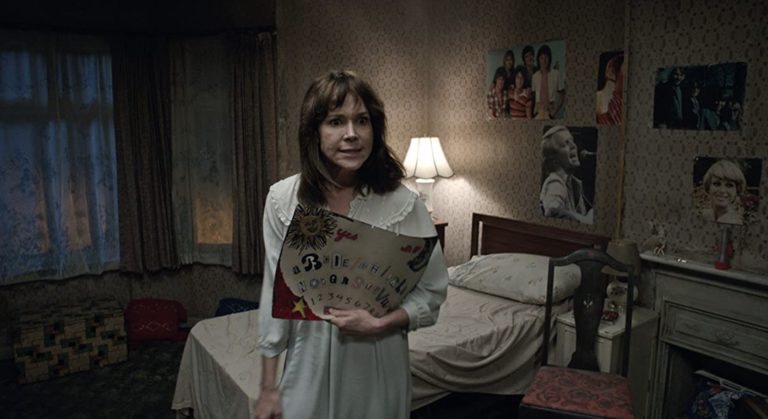
As the second Conjuring movie (and the third film in the shared Conjuring universe), The Conjuring 2 follows the continuing exploits of paranormal investigators Ed and Lorraine Warren (Patrick Wilson and Vera Farmiga). The Warrens visit the London home of the Hodgson family who are experiencing supernatural activity. The movie is a mix of poltergeist and possession films, with the family’s second oldest daughter, Janet (Madison Wolfe) being the focus of both types of paranormal phenomena. In the movie we see Janet’s homemade ouija board, the likely conduit through which whatever is in the house gained entry. The Conjuring 2 is a tense and entertaining entry in the popular franchise, and it’s notable for introducing audiences to two new and interesting ghosts: The Crooked Man and The Nun.
Ouija: Origin of Evil (2016)
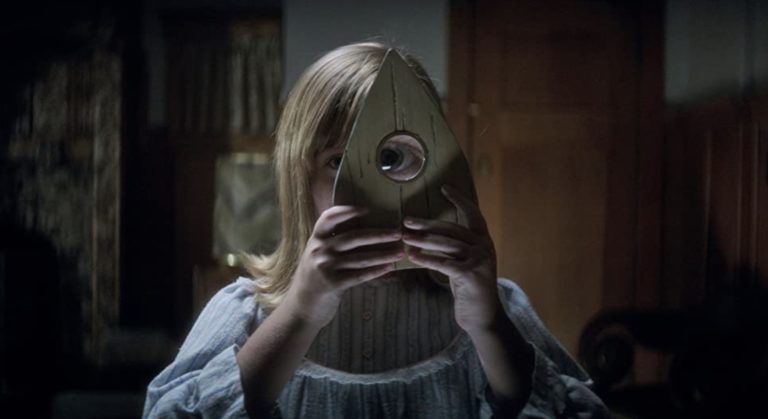
Directed by Mike Flanagan (Doctor Sleep, The Haunting of Hill House), Oujia: Origin of Evil is superior to its predecessor Ouija (2014) in most ways. The story follows Alice (Elizabeth Reaser), a fake medium who swindles people by performing staged séances with the help of her daughters Doris (Lulu Wilson) and Lina (Annalise Basso). When Alice adds a Ouija board to her charade, she unwittingly makes contact with a force that young Doris believes is her deceased father. Doris becomes the target of possession by whatever has come through the Ouija board, and the movie plays out as a nicely scary possession movie and one of the better films in which a Ouija board plays an extensive role.
Verónica (2017)
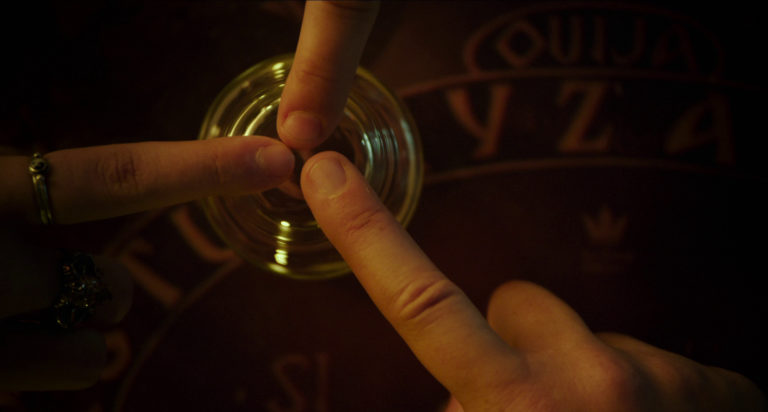
Inspired by the real-life story of Estefania Gutiérrez Lázaro, an 18-year-old girl whose death in 1991 was allegedly attributed to her use of a Ouija board, Verónica is a Spanish film that tells the story of a catholic high school girl who becomes the target of possession after dabbling in the occult. Verónica, played wonderfully by Sandra Escacena in her film debut, attempts to contact her deceased father through a Ouija board with the help of two of her friends. Verónica’s friends back away as the glass the girls use for the Ouija session takes on a life of its own, but Verónica is put into a trance-like state that ends with her passing out. Over the next few days, Verónica has nightmares and experiences increasingly terrifying supernatural activity, all leading up to the film’s inevitably tragic climax. Verónica is an effective and scary possession movie with images that can’t soon be forgotten.
Ouija Room (2019)

Sylvia (Joni Durian) lives a lonely life. She suffers from agoraphobia (among a myriad of self-destructive issues) which keeps her cooped up inside all the time, and she is under the guardianship of her loving but burned-out older brother. One day she decides to use a ouija board to make friends with the spirits she contacts, but her new friends quickly start to feed Sylvia’s more destructive tendencies. Ouija Room is a unique take on what a ouija movie can be, mixing psychological drama with the more usual ouija-based scares. The low-budget quality can come across a bit comical at times, but the fun performance from Joni Durian keeps the film engaging whenever the story starts to feel ridiculous.
More Ouija Board Movies
- When the Clouds Roll By (1919) is a comedy starring Douglas Fairbanks, and the film’s use of a Ouija board features no supernatural elements as the characters push the planchette around on their own as they coyly talk to each other.
- The Oujia Board (1920) is part of a series of comedy shorts by Max Fleischer collectively called Out of the Inkwell, and Ouija is once again used for comedy rather than supernatural scares.
- Straight is the Way (1921) employs a Oujia board to inform a cash-strapped woman and her niece that there is treasure hidden in their house in this light-hearted silent comedy.
- Charlie Chan’s Secret (1936) features two séances as the titular detective attempts to solve the mystery of the murder of an heir to a fortune, and a Ouija board is seen briefly as the victim’s aunt uses the device with her butler.
- Mother’s Day (1980) is a low-budget, black-comedy revenge movie about a deranged mother and her two murderous sons who kidnap and torture three women. When the women escape, one of the sons turns to a Ouija board for help, though the spirit he contacts must be as illiterate as he is.
- Deadly Messages (1985) features a couple of uses of a Ouija board to unravel a rather convoluted plot in this made-for-TV mystery.
- The Chill Factor (1993), also known as Demon Possessed, features a ouija-like board referred to in the film as a “devil eye.” The movie features a group of people stranded in a snow-covered cabin who unleash a demonic force after using the devil eye.
- Grim (1995) uses a ouija-like board to summon a huge monster that stalks a group of spelunkers. The movie has some nice gore and a memorable monster, but there’s a lot of downtime between the action.
- Kokkuri (1997) is a creepy entry in the Japanese horror boom of the late 1990s featuring ominous predictions made by a spirit board inspired by Ouija boards.
- Holy Terror (2002) is a micro-budget bit of schlock featuring gratuitous nudity and an evil nun who (eventually) murders everyone after she is summoned by a Ouija board.
- Exorcism: The Possession of Gail Bowers (2006) has a familiar-feeling plot structure inspired by other ouija-leads-to-possession movies, but it has some really nice visuals during the exorcism in the climax of the film.
- Ju-On: White Ghost (2009), like other films in the Ju-On franchise, features a collection of interconnected ghostly tales. One story features school girls playing “kokkuri,” a game virtually identical to Ouija.
- The Unleashed (2011) is a fairly standard possession movie about a woman who becomes the target of something sinister after finding an ancient Ouija board in the attic of her family home.
- Seance: The Summoning (2011) involves a séance gone wrong in a morgue when a man is possessed by a demon during a session with a ouija-like board. His friends attempt to subdue and exorcise him before he gets loose and murders them in particularly gruesome ways.
- The Ouija Experiment (2011) includes scares fairly typical of the found-footage subgenre. The immersion is broken from time to time, but fans of the found footage style may want to give it a shot.
- Grave Encounters 2 (2012) features a group of film students who attempt to make a documentary proving that the first Grave Encounters (2011) film was real. During a session with a makeshift ouija board, they awaken the paranormal entity that killed the cast of the movie, thus creating their own found-footage movie by accident.
- The Addicted (2013), also known as Rehab, is a low-budget horror movie about a news reporter who ends up in a fight for her life as she and her friends are stalked by a supernatural killer in an abandoned drug rehab facility. A Ouija board features briefly in the opening scene, right before the blood starts flying.
- Tape_13 (2014) is a found-footage movie that follows a couple, while on vacation in Germany, who end up in a cabin in the woods with some new friends. Playing with a Ouija board begins a series of supernatural occurrences that build up to a finale seemingly inspired by The Blair Witch Project (1999).
- Demon Legacy (2014) is the story of five sorority sisters at a remote forest cabin who unleash an evil entity when they unearth an old Ouija board. This low-budget film is notable for featuring Eileen Dietz, the face of Pazuzu in The Exorcist (1973).
- The Ouija Experiment 2: Theatre of Death (2014) contains an interestingly meta scenario where the cast of the first Ouija Experiment (2011) play themselves as they are haunted during a screening of their film.
- Evil Deeds: Full Circle (2016) is an anthology film containing a series of horror-themed shorts, including a tale of a vengeful spirit unleashed by a Ouija board.
- Ghost Team (2016) stars Jon Heder and Justin Long as wannabe ghost hunters in this fun indie comedy. The Ghost Team (as they call themselves) begins their investigation in an old barn with a Ouija session moderated by a medium played by Amy Sedaris.
- Escape Room: Quest of Fear (2018) features a Ouija board early in this low-budget Russian horror film as a means to get a group of friends to participate in an escape room game that turns deadly.
- The Addams Family (2019) includes a scene where Morticia Addams uses a Ouija board to contact her dead relatives in this animated family comedy.
- Weedjies: Halloweed Night (2019) is a horror comedy in the vein of Ghoulies about tiny monsters (the titular Weedjies) who are unleashed via a Weed-G-Board. Unsubtle marijuana jokes abound in this silly comedy from Full Moon Features.
- Ouija House (2019) attempts to create a new type of possession as a young woman is turned into a human planchette who is compelled to run around a house pointing at letters painted on the walls.
- Ouija Shark (2020) is as ridiculous as the title sounds. A makeshift ouija board made out of driftwood summons a ghostly shark that hunts people from swimming pools to cabins in the woods.
- Ouija Warehouse (2021) is writer/director Israel Luna’s third Ouija-related low-budget horror film, this time following a group of friends as they are haunted after finding a Ouija board in a warehouse. Also known as Ouija: Deadly Reunion.
- Ouija Japan (2021) is a super-low-budget “battle royale” style movie with the killing initiated by a Japanese ouija (kokkuri) board.
